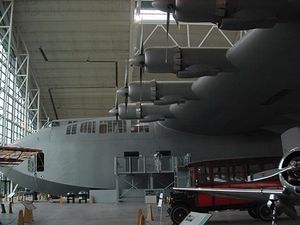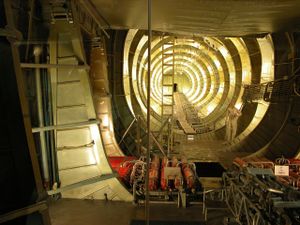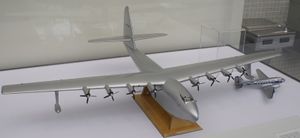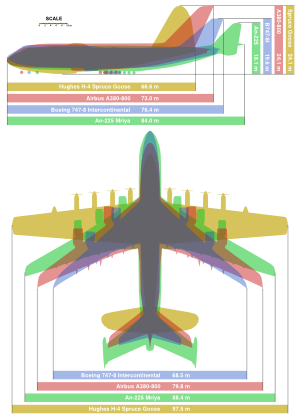PlaneSpottingWorld welcomes all new members! Please gives your ideas at the Terminal.
Hughes H-4 Hercules
| H-4 Hercules "Spruce Goose"
| |
|---|---|
| Type | Very heavy transport |
| Manufacturer | Hughes Aircraft |
| Designed by | Howard Hughes Henry J. Kaiser |
| Maiden flight | 2 November 1947 |
| Retired | 5 April 1976 |
| Status | Museum piece |
| Number built | 1 |
The Hughes H-4 Hercules ("Spruce Goose") is an aircraft which was designed and built by Howard Hughes' Hughes Aircraft company. Its first and only flight took place in 1947. Hughes himself detested the nickname "Spruce Goose". The nickname arose as a way of mocking the Hercules project due to Hughes' alleged misuse of government funding to build the aircraft. The Hercules is the largest flying boat, and still holds the record for the largest wingspan of any aircraft in history. Only one was ever built.
Due to wartime restrictions on the availability of metals, the H-4 was built almost entirely of laminated birch, not spruce as its nickname suggests. The aircraft was a technological marvel of its time. It married a soon-to-be outdated technology, flying boats, to a massive airframe that required some truly ingenious engineering innovations to function.
History

In 1942, the U.S. Department of War was faced with the need to transport war matériel and personnel to Britain. Allied shipping in the Atlantic Ocean was suffering heavy losses to German U-boats, so a requirement was issued for an aircraft that could cross the Atlantic with a large payload.
The aircraft was the brainchild of Henry J. Kaiser, who directed the Liberty ships program. He teamed with aircraft designer Howard Hughes to create what would become the largest aircraft built or even seriously contemplated at that time. When completed, it was capable of carrying 750 fully-equipped troops or two M4 Sherman tanks.
To conserve metal for the war effort, it would be built mostly of wood; hence, the "Spruce Goose" moniker. It was also referred to as the Flying Lumberyard by critics who believed an aircraft of its size physically could not fly.
Development dragged on and was not completed until well after the war was over. There were many reasons for this, not least of which was Hughes' mental breakdown during development. In 1947, Howard Hughes was called to testify before the Senate War Investigating Committee over the usage of government funds for the aircraft, as Congress was eliminating war-era spending to free up federal funds for domestic projects. Though he encountered skepticism and even hostility from the committee, Hughes remained unruffled. During a break in the hearings, he returned to California, ostensibly to run taxi tests on the H-4. On the 2nd of November in 1947, with Hughes at the controls, the Hercules lifted off from the waters off Long Beach, remaining airborne 70 feet (20 m) off the water at a speed of 80 mph (130 km/h or 70 knots) for just under a mile (1.6 km). At this altitude, the plane was still experiencing ground effect and some critics believe it lacked the power necessary to climb above ground effect.
Hughes had answered his critics, but the justification for continued spending on the project was gone. Congress ended the Hercules project, and the aircraft never flew again. It was carefully maintained in flying condition until Hughes' death in 1976.
Claims
Hughes had his entire reputation wrapped up in the H-4 and often said that if the Hercules did not fly he would probably leave America and never return. In a transcript of a Senate hearing, Hughes said the following:
| “ | The Hercules was a monumental undertaking. It is the largest plane ever built. It is over five stories tall with a wingspan longer than a football field. That's more than a city block. Now, I put the sweat of my life into this thing. I have my reputation all rolled up in it and I have stated several times that if it's a failure I'll probably leave this country and never come back. And I mean it. | ” |
In 1980, the Hercules was acquired by the California Aero Club, who successfully put the aircraft on display in a large dome adjacent to the Queen Mary exhibit in Long Beach, California. In 1988, The Walt Disney Company acquired both attractions. Disappointed by the lackluster revenue the Hercules exhibit generated, Disney began to look for another organization to take the exhibit off its hands. After a long search for a qualified buyer, the plane was acquired by the Evergreen Aviation Museum in 1993, who disassembled the aircraft and moved it by barge to its current home in McMinnville, Oregon (about an hour southwest of Portland) where it has been on display since.
By the mid-1990s, Hollywood converted the former Hughes Aircraft hangars, including the one that held the Hercules, into sound stages. Scenes from movies such as Titanic, What Women Want, and End of Days have been filmed in the 315,000 square foot (29,000 m²) airplane hangar where Howard Hughes created the legendary flying boat. The hangar will be preserved as a structure eligible for listing in the National Register of Historic Buildings in what is today the housing development Playa Vista.
Though the project was a failure, the H-4 Hercules, in some senses, presaged the massive transport aircraft of the late 20th century, such as the Lockheed C-5 Galaxy, the Antonov An-124 and the An-225. The Hercules demonstrated that the physical and aerodynamic principles which make flight possible are not limited by the size of the aircraft, even if the viability of the airplane itself is, mainly due to the lack (at that time) of strong enough engines.
-
News story on the Spruce Goose (file info)
- Video of the plane's construction
- Problems seeing the videos? See media help.
On screen
The construction and flight of the Hercules was featured in the 2004 Hughes biopic The Aviator. Motion control and remote control models, as well as partial interiors and exteriors, of the aircraft were reproduced for this scene. The motion-control Hercules is on display at the Evergreen Aviation Museum, next to the real Hercules.
The Hercules was also the subject of a Yogi Bear movie entitled "Yogi Bear and the Magical Flight of the Spruce Goose"
In the animated television series TaleSpin, there was an aircraft called the "Spruce Moose".
A model of the Hercules is featured in a scene of The Rocketeer.
It was parodied in The Simpsons in the episode $pringfield (Or, How I Learned to Stop Worrying and Love Legalized Gambling), where Mr. Burns shows a model aircraft to Mr. Smithers he calls the "Spruce Moose". Also, in Midnight Rx he owns a plane called the Plywood Pelican. He summarized its history as "I flew it at an altitude of six feet for a distance of four and a half feet. We later learned that rain makes it catch fire. Then the Führer fired me." Later in the episode he used it to smuggle in massive amounts of prescription drugs from Canada.
Specifications (H-4)
Performance specifications are projected. Template:Aircraft specification
External links
- Evergreen Aviation Museum, McMinnville, Oregon, home of the plane.
- Spruce Goose: Where Is It Now?: A history of the plane following Hughes' death.
- The Aviator (2004) Biography/drama movie about Howard Hughes with H-4 Hercules Spruce Goose episode.
Related content
Comparable aircraft
Related lists
See also
Giant aircraft | |
|---|---|
| Production | |
| Prototypes | |
| Concepts | Proposed: Airbus A380-900 · Reaction Engines A2 · Beriev Be-2500 · Boeing 747-8 · Abandoned: Boeing New Large Airplane · Boeing Pelican · McDonnell Douglas MD-12 |
| Wingless aircraft | Biggest airship: Luftschiffbau Zeppelin Hindenburg class · Biggest blimp: Goodyear ZPG-3W · Biggest helicopter: Mil Mi-12 |
Lists relating to aviation | |
|---|---|
| General | Timeline of aviation · Aircraft · Aircraft manufacturers · Aircraft engines · Aircraft engine manufacturers · Airports · Airlines |
| Military | Air forces · Aircraft weapons · Missiles · Unmanned aerial vehicles (UAVs) · Experimental aircraft |
| Notable incidents and accidents | Military aviation · Airliners · General aviation · Famous aviation-related deaths |
| Records | Flight airspeed record · Flight distance record · Flight altitude record · Flight endurance record · Most produced aircraft |
de:Hughes H-4 es:Hughes H-4 Hercules fr:Hughes H-4 Hercules ja:H-4 (航空機) pl:Hughes H-4 Hercules pt:H-4 Hercules sl:Hughes H-4 Hercules fi:Hughes H-4 Hercules sv:Hughes H-4 Spruce Goose



